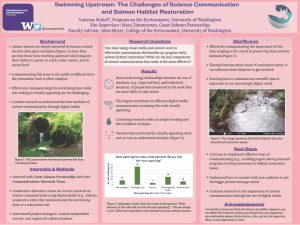Swimming Upstream: The Challenges of Science Communication and Salmon Habitat Restoration
Habitat restoration efforts are an incredibly important way to preserve pristine natural environments and reverse degradation. The Washington Coast contains some of the best, last resorts to ensure that native species, specifically salmon populations, are able to restore themselves to historic levels. Restoration efforts in these areas largely go unnoticed since they typically occur in remote parts of the Olympic Peninsula, but if more people are able to see the results of this work, they are more likely to get involved. The purpose of this study was to better understand the most effective ways to communicate scientific knowledge through the use of digital media, specifically through a produced video. Additionally, the study aimed to include the learned ways, e.g., avoiding jargon, of communicating into the produced video to showcase the working being done at the Coast Salmon Partnership’s restoration sites. To accomplish this task, I completed an internship with the Coast Salmon Partnership, conducted extensive research by reading peer-reviewed articles that demonstrated the most effective ways to communicate scientific knowledge, specifically regarding salmon and habitat restoration, through digital media, and completed a literature review. Findings show that communication should be as simple as possible, visually appealing, and to avoid using complicated jargon. If one is able to better communicate the work that is being done, it becomes easier for a wider audience to be aware of the organization, the work that is being done, and the goals that are being worked towards.
